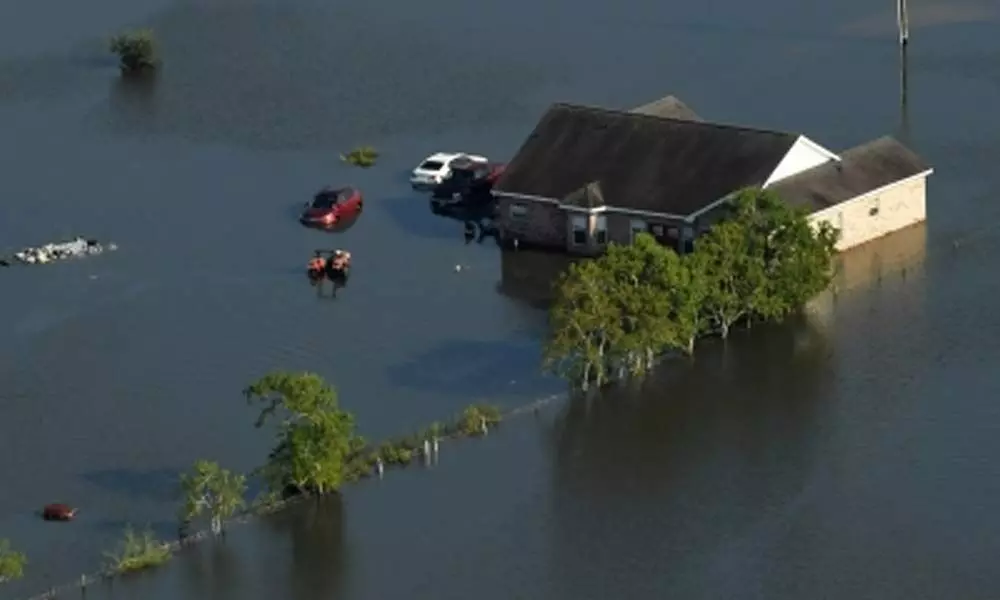Live
- They always want me to win, and now I feel lucky to have been offered a story like ‘Zebra’: Satyadev Kancharana
- ‘Democracy first, humanity first’: PM Modi in Guyana's parliament on two countries' similarities
- PKL Season 11: Telugu Titans register third straight win to top standings
- Is Pollution Contributing to Your COPD?
- NASA Unveils Underwater Robots for Exploring Jupiter's Moons
- Additional Central forces arrive in violence-hit Manipur
- AR Rahman and Saira Banu’s Divorce: Legal Insights into Common Issues in Bollywood Marriages
- 82.7 pc work completed in HPCL Rajasthan Refinery area: official
- Curfew relaxation extended in 5 Manipur districts on Friday
- Tab scam prompts Bengal govt to adopt caution over fund disbursement
Just In

For representational purpose (Photo/IANS)
UN University-led experts have created a new public tool that generates instant, accurate street-level resolution maps of floods worldwide since 1985.
New Delhi: UN University-led experts have created a new public tool that generates instant, accurate street-level resolution maps of floods worldwide since 1985.
The free online World Flood Mapping Tool will help all countries but especially those in the Global South, where flood risk maps are rare and often badly out of date.
Created by the UN University's Institute for Water, Environment and Health in Hamilton, Canada, with support from Google, MapBox and other partners, the tool lets users adjust variables to help locate gaps in flood defences and responses, and to plan future development of all kinds -- for example, where to build or upgrade infrastructure, or develop agriculture.
Says UNU-INWEH Director Vladimir Smakhtin: "Floods in the past decade have impacted the lives of more than half a billion people, mainly in low and middle-income countries, and resulted in damages of nearly $500 billion -- roughly equal to the GDP of Singapore. More recent floods worldwide have added to a fast growing toll of upended lives, damage and deaths.
"An estimated 1.5 billion people -- greater than the population of Europe -- live at risk of exposure to intense flooding."
"We need to prepare now for more intense and more frequent floods due to climate change and hope this tool will help developing nations in particular to see and mitigate the risks more clearly."
Hamid Mehmood, a GIS and remote sensing specialist at UNU-INWEH who led the tool's development, says a UNU-INWEH survey showed a majority of flood forecasting centres in flood-prone countries lack the ability to run complex flood forecasting models.
He adds that floods like those this year in Europe that killed more than 200 people and caused billions of dollars in damages are now up to nine times more likely because of climate change.
"As temperatures continue to rise the number of flood events will increase along with their severity," he said.
"No place is immune. And yet remarkably few regions, even in wealthy countries, have useful, up-to-date flood maps because of the cost and difficulty of creating them."
The World Flood Mapping Tool uses the Google Earth Engine combined with decades of Landsat data since 1985 -- a vast catalog of geospatial data enabling planet-scale analysis capabilities.
Layers of Landsat information for a selected region and specified timeframe identifies temporary and permanent water bodies while integrating site-specific elevation and land-use data.
This produces a detailed map of flood inundation in recent decades, with available overlays of population, buildings and land use, which can be used for community planning, building zoning, insurance assessments and more.
To validate the technology, maps generated in less than a minute using the new tool were compared to documented flooding events in Australia, Bangladesh, Canada, Cambodia, India, Mozambique, Sri Lanka and Thailand, with 82 per cent accuracy achieved.
The new tool will also reflect new floods soon after they occur to provide the most up-to-date maps to help assess overall flood impacts and plan for the future.
"Painting a detailed picture of the historical and potential flood risk areas will be invaluable for any urban and regional planning department," says project collaborator Duminda Perera of UNU-INWEH.
The new World Flood Mapping Tool enables governments, funding agencies, and disaster management authorities to hone in on the highest potential risk locations of flooding in the future.
Knowing exactly where flooding will occur can maximise the effectiveness of investments in public infrastructure and reduce costs.

© 2024 Hyderabad Media House Limited/The Hans India. All rights reserved. Powered by hocalwire.com







